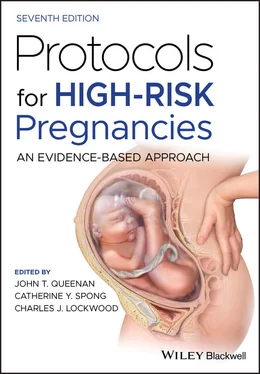Beta‐thalassemia is an autosomal recessive disorder affecting the HBB gene on chromosome 11 which leads to underproduction or absent production of the beta globin protein. In the homozygous form, the severity of the disease depends on whether beta globin production is simply reduced (beta +) or if production is absent (beta 0). In utero, patients with severe beta‐thalassemia are protected from anemia due to normal fetal hemoglobin production but quickly require treatment and transfusion within the first year of life. Heterozygous forms of beta‐thalassemia are called beta‐thalassemia minor (or beta‐thalassemia trait) and have a variable degree of anemia depending on the rate of beta globin production.
Patients at risk of being a carrier or being affected by a hemoglobinopathy should be screened appropriately in order to assess fetal and maternal risks in pregnancy. The American College of Obstetricians and Gynecologists currently does not support universal hemoglobinopathy screening.
At‐risk groups for hemoglobinopathies include high‐risk ethnic groups and patients with unexplained microcytic anemia. Persons of African, Mediterranean, Southeast Asian, Middle Eastern, and West Indian descent should be considered high risk. Initial screening should include a hemoglobin electrophoresis. Sickle cell solubility tests are not an adequate initial screen as they will not differentiate SCD from sickle cell trait, and they can miss compound heterozygotes.
Hemoglobin electrophoresis results will vary with the disease state present. Normal hemoglobin electrophoresis results show 95–98% HbA, 2–3% HbA2, and 0.8–2% HbF. Sickle cell disease, sickle cell trait, and beta‐thalassemia syndromes will be diagnosed on electrophoresis. Alpha‐thalassemia cannot be diagnosed by electrophoresis and instead requires genetic testing.
For patients with a microcytic anemia on routine laboratory testing, additional testing is warranted. The majority of cases of microcytic anemia are due to iron deficiency anemia; however, among patients in whom iron deficiency has been ruled out and who have a normal hemoglobin electrophoresis, genetic testing for alpha‐thalassemia trait should be completed.
If the patient is noted to be affected or a heterozygous carrier, paternal testing should be completed to determine fetal risks. Pregnancies at risk of an affected fetus (including pregnancies where both parents are carriers or where one parent is a carrier and one parent is affected) should be referred for genetic counseling for full assessment of inheritance risk and discussion of prenatal testing options including fetal diagnostic testing through chorionic villus sampling and amniocentesis depending on gestational age. Noninvasive prenatal tests for cell‐free DNA in maternal circulation are in development but currently there are no validated tests for hemoglobinopathy. In patients presenting for preconception counseling with a known risk for conceiving an affected fetus, preimplantation genetics and in vitro fertilization is an option.
Role of transfusion therapy
Red blood cell transfusions are required by 50% of patients with SCD. The role of transfusion in the management of SCD during pregnancy remains controversial. Therapeutic transfusion is beneficial in patients with a severe anemia (typically <7 g/dL or a significant decrease from the patient’s baseline) or in those with acute stroke, acute chest syndrome, acute symptomatic anemia, reticulocytopenia (often associated with parvovirus B19 or other infections) or acute multiorgan failure.
The role of prophylactic transfusion and exchange transfusion is less clear in pregnancy. A 2016 Cochrane review found insufficient evidence to support prophylactic transfusions. In their review, one small, low‐quality study was identified which showed a reduction in the risk of pain crisis in patients receiving prophylactic transfusions compared to selective transfusion but failed to show benefit in reduction of maternal or perinatal mortality, or severe maternal morbidity.
In anemic women undergoing planned surgery, cesarean delivery for example, a preoperative transfusion can be considered to prevent postoperative severe anemia and potential postoperative complications.
Given the high frequency of transfusion in these patients, it is imperative to ensure appropriate cross‐matching for minor blood antigens to avoid both transfusion reactions and antibody development to antigens which may limit future availability of blood products for these patients. Overall alloimmunization development rates have ranged between 6% and 85% depending on the study. A systematic review of the available literature did not identify an ideal cross‐matching approach. It is reasonable to attempt strict cross‐matching and consider leuko‐reduced and/or cytomegalovirus (CMV)‐negative blood to limit transfusion reactions and infections in this patient population. In patients affected by SCD, early preparation and cross‐matching of appropriate blood products should be strongly considered in order to have products available in the event of peripartum hemorrhage, crisis, or other adverse outcome.
Pregnancy management of sickle cell disease
Preconception counseling
Referral to maternal‐fetal medicine to discuss maternal/fetal risks during pregnancy.
Paternal screening (hemoglobin electrophoresis and/or alpha‐thalassemia genetic screening) for risk assessment of fetal genetic inheritance.
Discontinuation of hydroxyurea and ACE inhibitors prior to conception.
Evaluate for chronic opioid use; counsel accordingly regarding the risk of neonatal abstinence syndrome.
Maternal screening for end‐organ damage and baseline lab assessment including CBC, reticulocyte counts, liver function tests, renal function tests, type and screen, rubella and varicella immunity screening, EKG, and echocardiogram (if numerous crises/history of acute chest syndrome).
Discuss maternal immunization as SCD causes patients to be functionally asplenic. Patients with SCD should receive the following (in conjunction with SCD provider).Haemophilus influenzae type B (Hib) vaccine: one dose during their lifetime.Meningococcal vaccine: two‐dose series at least eight weeks apart initially and revaccination every five years.Pneumococcal vaccine: one dose of PCV13 followed by one dose of PPSV23 at least eight weeks later. Repeat PPSV23 five years after initial PPSV23.Yearly influenza vaccine.
Ensure patient has established care with a SCD provider/hematologist for chronic disease care and health maintenance.
Recommend folic acid supplementation (4 mg/day).
Early establishment of care with obstetrician, maternal‐fetal medicine specialist, and hematologist/SCD provider.
Stop hydroxyurea and ACE inhibitors if not previously discontinued.
Obtain baseline maternal serum labs including CBC, reticulocyte counts, lactate dehydrogenase, liver function tests, renal function tests, iron studies, urinalysis/urine culture.
Maternal echocardiogram if the patient has a history of multiple crises and/or acute chest syndrome as these patients are at increased risk of pulmonary hypertension. There is currently not enough evidence to make a recommendation on universal pulmonary hypertension screening in this population.
Paternal screening (hemoglobin electrophoresis and/or alpha‐thalassemia genetic screening) if not previously completed for risk assessment of fetal genetic inheritance.
Referral to genetic counseling if father is a carrier or if paternity is unknown/unable to be tested.
Early ultrasound to confirm viability of the pregnancy.
Pregnancy options counseling.
Laboratory monitoring every trimester (CBC, urine culture).
Читать дальше












